to the index page
For two weeks in August 2010, Joy and I traveled around Taiwan with family. I met aunts, uncles, cousins, grandparents, great-grandchildren, and friends. We took trains most of the way around the island, visiting some of its most scenic spots and eating excellent food. I will write my usual travel story soon, but for now here are photos. Captions are yet to be written.
Have time and fast internet? Visit another page with twice as many photos.
I have endeavored to condense the prolific photographic record of this trip into something you can glance through in a conveniently short time. However, there were so many great moments that I am for the first time providing a second webpage for the same trip, with a more complete photo story. Follow the link. Photos are by me, Adrian, Jomay, and Joy.
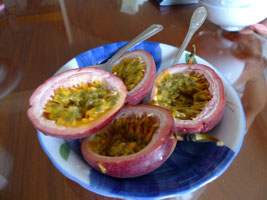
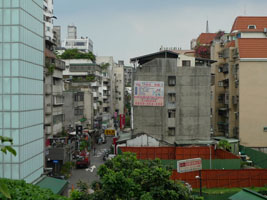
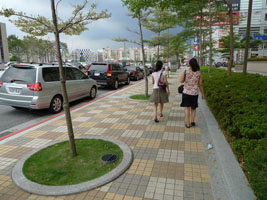
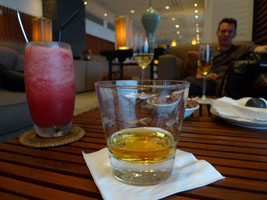
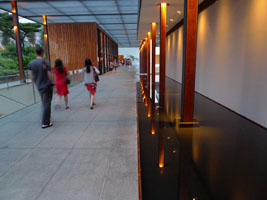
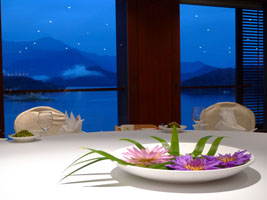
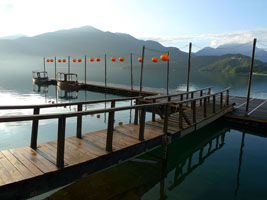
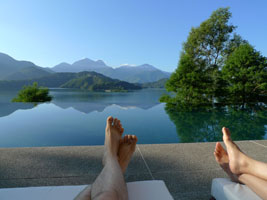
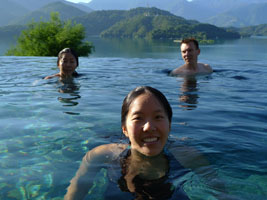
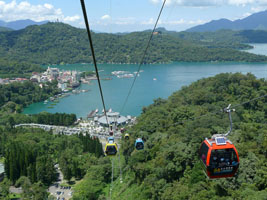
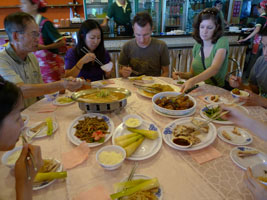
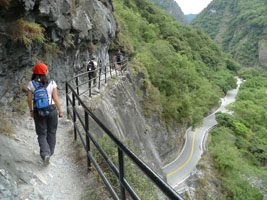
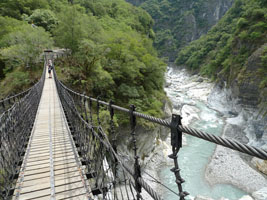
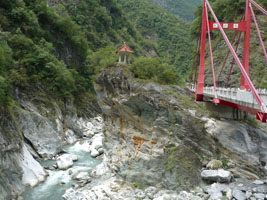
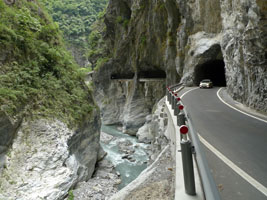
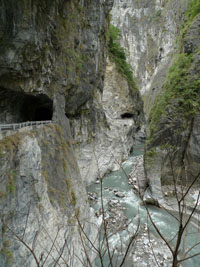
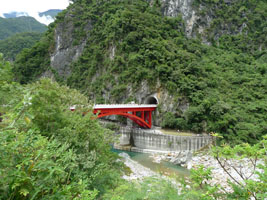
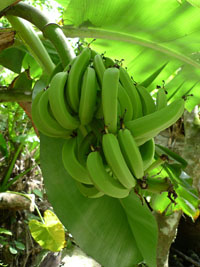
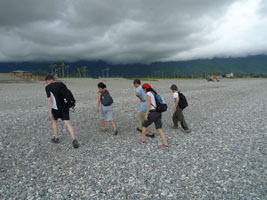
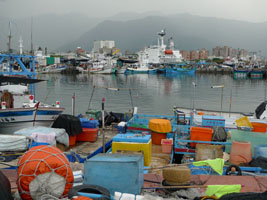
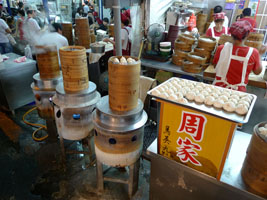
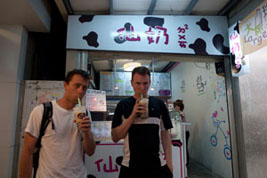
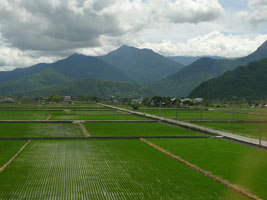
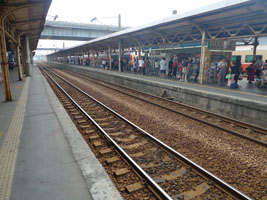
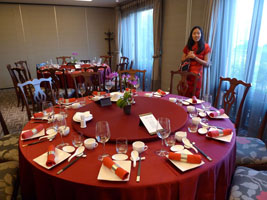
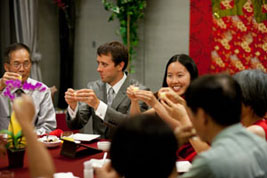
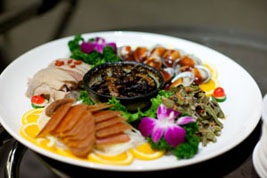
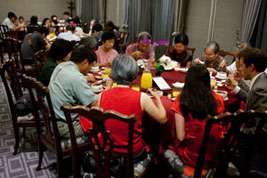
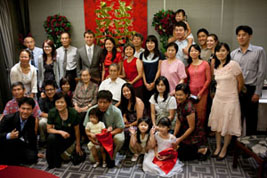
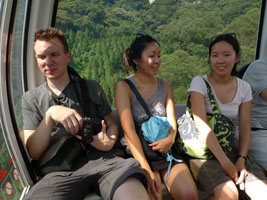
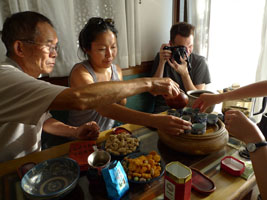
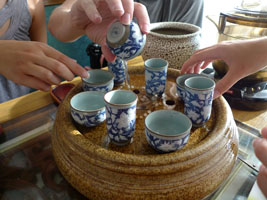
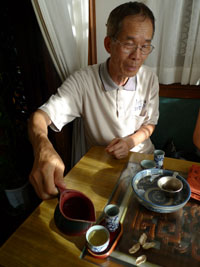
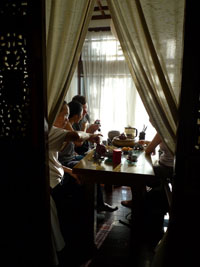
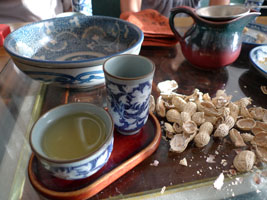
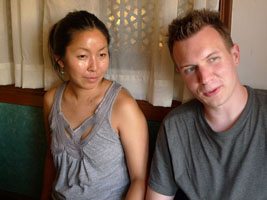
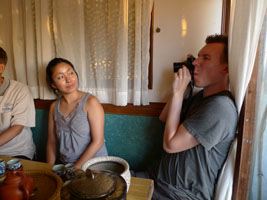
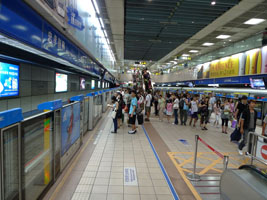
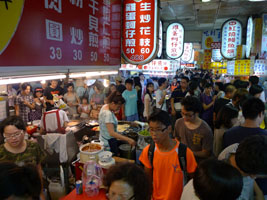
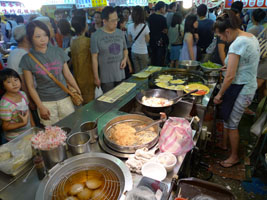
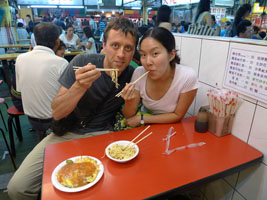
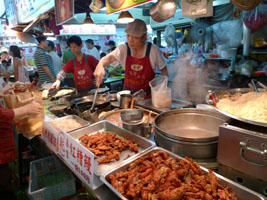
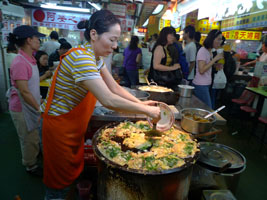
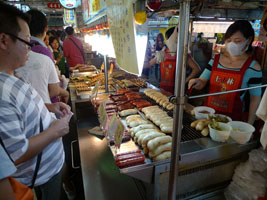
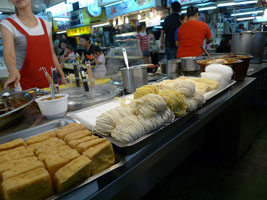
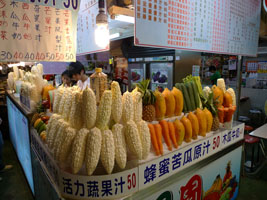
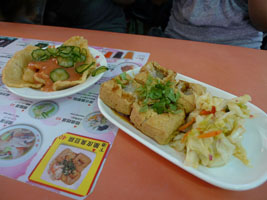
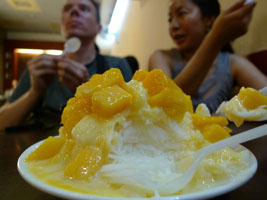
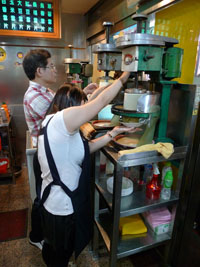
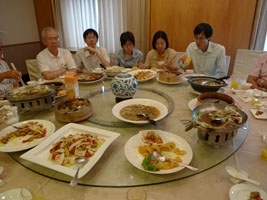
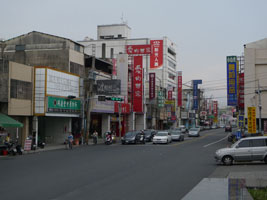
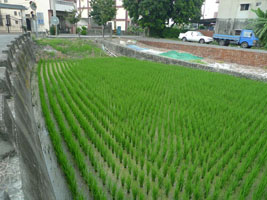
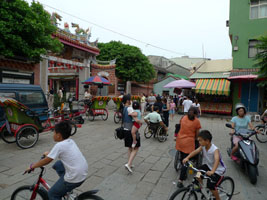
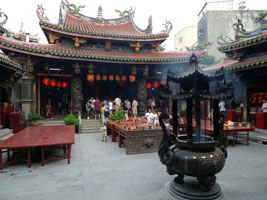
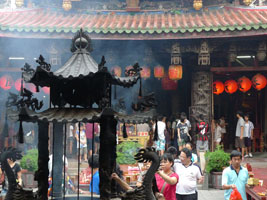
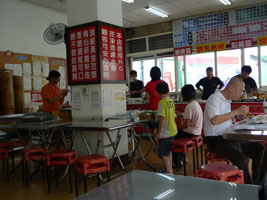
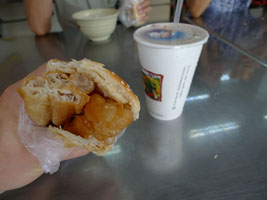
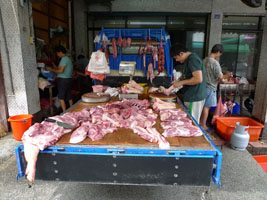
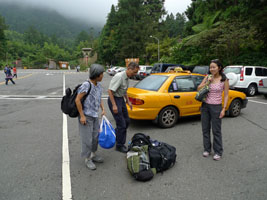
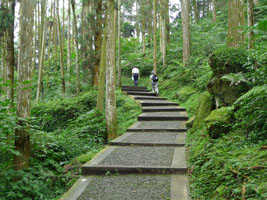
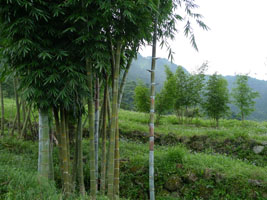
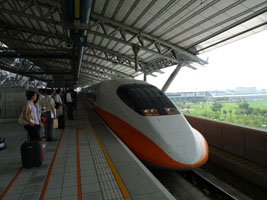
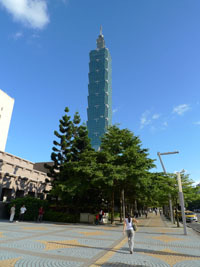
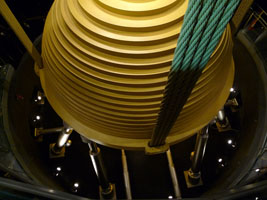
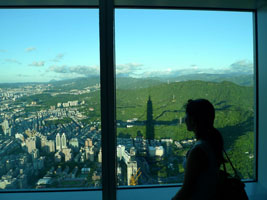
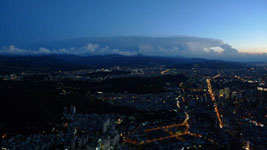
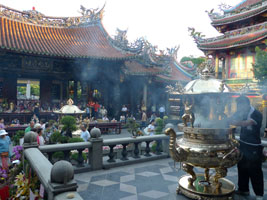
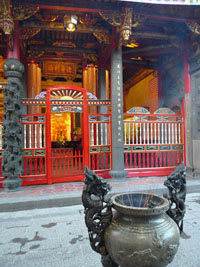
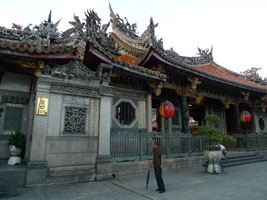
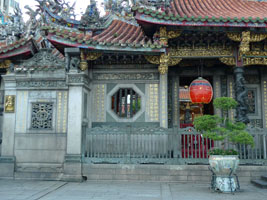
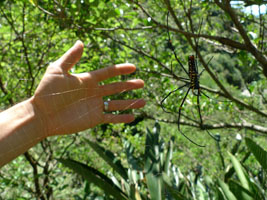
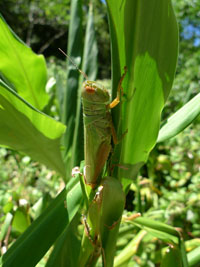
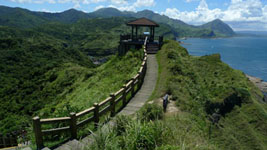
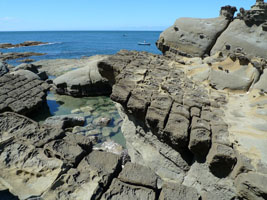
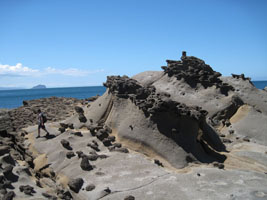
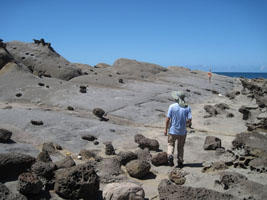
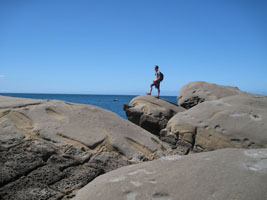
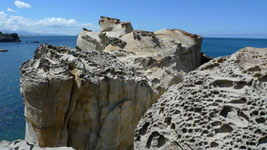
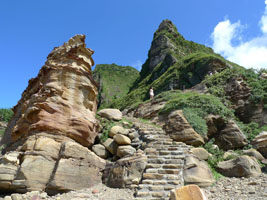
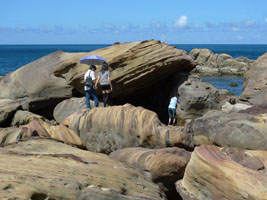
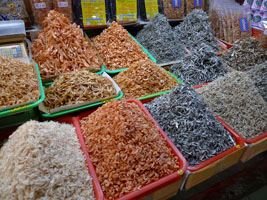
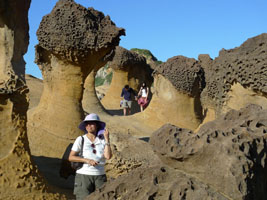
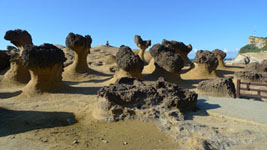
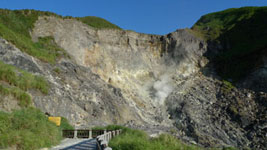
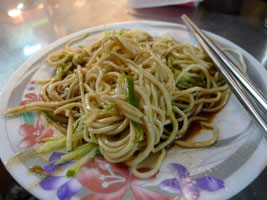
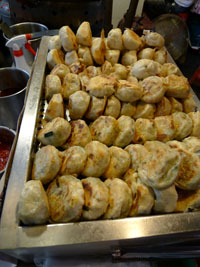
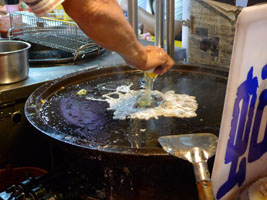
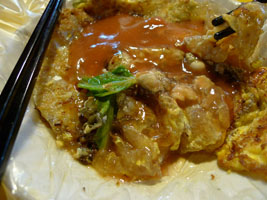
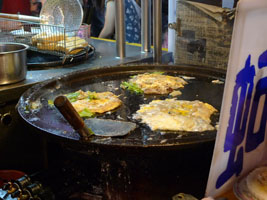
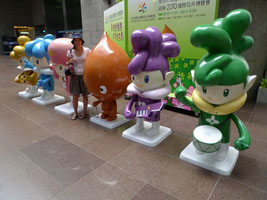
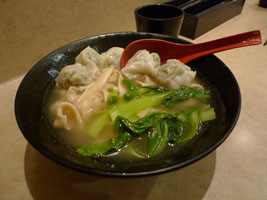
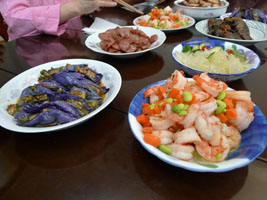
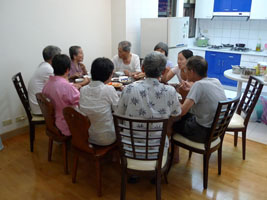
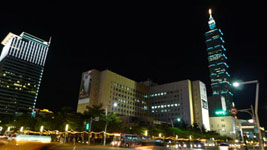
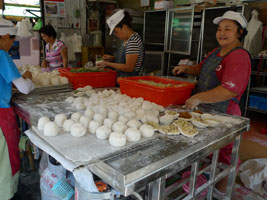
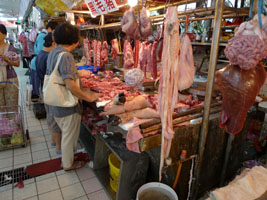
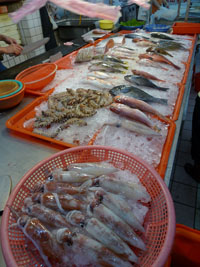
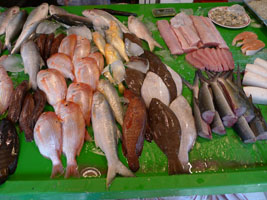
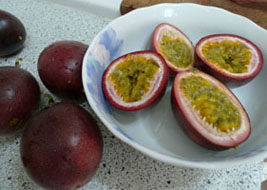
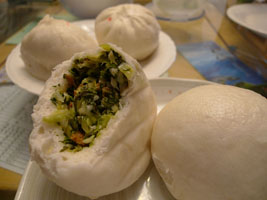
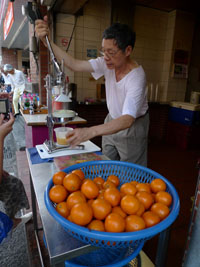
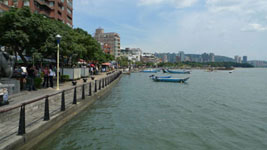
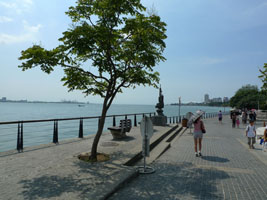
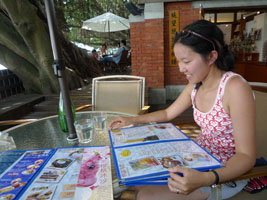
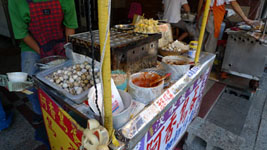
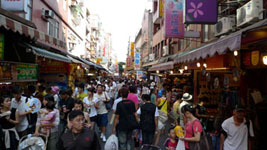
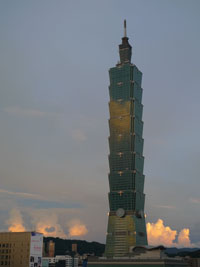
Plunging into the depths of the Pacific Ocean, Perseid meteors scratched quickly-fading white lines through the black void beyond my airplane window. This flight from San Francisco to Taipei seemed to go on forever through an endless night. Falling stars went all the way down to the horizon, a faint line apparent only from the absence of stars below its great circle. Everything else was dark. I watched for ten minutes before trying once again to sleep.
At 5:30am in Taipei everything was asleep. Joy's parents had arrived earlier and already had a hotel room, where we left our bags. The whole family was gathering, Jomay and Adrian were with us, and various aunts, uncles, cousins were coming to join those who lived in Taipei. The occasion: a 90th birthday celebration for Joy's grandparents. It was the year of their 70th wedding anniversary, too. Finally I would meet the rest of the family.
The meeting, as it turned out, was a little anticlimactic. They mostly spoke their language, we mostly spoke ours, and despite our being together in the living room, exchanging friendly greetings, we remained half a world apart.
Taiwan is at the edge of the tropics where to withstand rain, heat, and humidity, uninteresting concrete and tile structures are the norm and everything else is plastic or plastic wrapped. The fresh fruit in grocery stores was neatly packed in plastic. Along the streets, shops sold a colorful array of cheap plastic goods. There was so much stuff to buy, all glittery and cheap and mostly made in foreign countries, that I wondered what people did for employment.
Chinese style, and Taiwanese too, values the use of fine building materials like polished marble and tropical hardwoods but still they manage only to produce buildings that feel empty, plain, sterile, and anything but extravagant. The comforts of a rough construction are absent, but so too is the pride and craft of fine construction. To me at least everything looks like a waste of good materials. Dilapidated block buildings are faced with white ceramic tile, now sooty and gray with grout lines turned an unappealing shade of black. Inside our hotels, rooms were ornately paneled with rich wood veneers that quickly become chipped to reveal the fine overlay. Is it mimicry with quality falling short, or is it a general lack of soul? Truly ancient Eastern styles, still found in old temples, museum collections, and rare pieces of new work, do exhibit character and preserve some of the spirit of the people who made them, but what constitutes the majority of modern construction is decidedly vacant in this sense.
Taiwan's unflattering urban landscape of grimy concrete smothered with superfluous plastic goods may be forgiven on consideration of the country's cuisine. An inversion of the American system, the Taiwanese cuisine is at its best when at it's cheapest. Fare from food courts and street vendors is usually quite healthful as well; vegetables and noodles and rice outshine our fried fast food and are much more satisfying in my opinion. On porcelain dishware, department store food courts serve hot meals cooked to order, loaded with colorful vegetables and tasty cuts of meat all perfectly seasoned. When on occasion we ate at more formal restaurants costing many times more, we found the food no better and sometimes inferior, which together with the steep price left us unsatisfied.
Another thing in favor of the food courts was that we could see exactly what our options were, either the food itself or plastic models of the food, while in restaurants we had to guess from a menu. Even when menus had pictures, this was not easy. Restaurants generally had fewer customers while the food courts were always packed with people and serving the freshest food on account of the high turnover.
Thunderstorms moved in as we returned to the hotel around 3pm and a heavy downpour arrived just we came inside. This cooled the air nicely from its midday temperature which was in the low 90s F. Inside the hotel and stores it remained as chilly as ever. They are certainly not frugal with air conditioning in Taiwan!
Adrian's friend Charles treated us to dinner at a favorite restaurant. Many of the foods we ate were spectacular, and we all became completely stuffed. Nonetheless we went out for dessert afterward. In the morning we gathered with Yola's family and boarded a chartered bus going south to Sun Moon Lake, a beautiful reservoir in the hills several hours travel south from Taipei. I met more aunts, uncles, cousins, and children of cousins. All but the youngsters were called by their common Chinese titles meaning "youngest uncle" or "third youngest uncle" or "eldest uncle." I never learned most of their names.
We stopped for lunch at a monastery called Chung Tai Chan, recently built at great expense to provide a bigger, better, modern place of worship for generations to come. There was plenty of parking, restaurant facilities of sufficient capacity, a museum with gift shop, lecture hall, and numerous rooms for scholarly studies. It was all very practical but apart from that the entire place seemed contrived, artificial, and not the product of human effort and attention or devotion. Polished granite, glass, and shiny bronze nicely accented the giant electronic marquee boards over the main entrance. In the way that a convention center space is an empty selfless shell into which almost any exhibit can fit harmoniously, the temple felt like it was waiting for a purpose.
The Japanese undertook many projects in Taiwan during their fifty year long occupation that started in 1894. In a grassy valley in the mountains they built a dam and created Sun Moon Lake, intending to farm fish and promote other industries. A bright blue gem a mile or two across at its outermost reaches, ringed by high forested hills, the lake now draws huge crowds of visitors from Taiwan and also from China. Several temples (old and built in the attractive, traditional style without polished stone and tinted glass) overlook the lake along with a great many hotels. Ours, the Lalu resort, must have been one of the nicest.
Perched high on a steep slope beside the lake and built with a zen architectural theme, it presented the landscape in a dramatic sweeping scene from every room and every floor. So intent were its designers on having a fine, clean appearance that key card proximity sensors were concealed behind thin wood paneling and electrical receptacles were hidden inside cabinets. It made a nice first impression and thereafter was terribly inconvenient.
Joy and I shared a suite with Jomay and Adrian. We slept in the children's room, the side of the suite that had two twin beds, A less grand bathroom, and more separation from the central living area. It was a beautiful place with wood paneling, tasteful lighting and decor, balconies looking out on the lake, white sheets and pillows, sofas and chairs, and a soaking tub and television that we never used.
Jomay made tea and we relaxed in the living room looking out over the lake while a heavy rain pelted down from the clouds, cooling the air and temporarily silencing the whir of insects. Later we walked around the grounds. The hotel had luxurious lounges, a bar, a games room and library area well-stocked with books in many languages; also a sixty meter long swimming pool where the water fills to the rim of the pool and spills over the edge giving the appearance of continuity with the lake below.
Elsewhere on the grounds, black granite reflecting pools with infinity edges were used in place of handrails as barriers atop precipices. The only thing preventing someone from walking off the edge of a forty foot wall was in some places a ten foot wide pool of water level with the floor and extending right up to the drop-off with no rim. It felt open, looked lovely, and instilled in me a persistent feeling of unease as I subconsciously questioned at every step whether I was about to unwittingly set foot into water instead of stone. It was only a foot or so deep, and while there was no chance of accidentally falling over the farther edge (even small running children would be effectively decelerated once in the water) there was a real risk of ending up wet and embarrassed.
We sipped hot tea, listened to the rain fall, and watched mist lift off the hills as the storm passed. It set the mood perfectly. At dusk the whole family - all 34 of us in attendance, which was almost all of Joy's mom's family, gathered in a large banquet room where surprisingly large round tables were set. By large round tables, I mean ones comfortably set for twenty people! They were enormous, far too large to speak across but completely serviceable on account of the large central rotating section.
Taiwanese banquets are rather different than I expected in their choice of food. In the US or Europe, one can expect a banquet to be of familiar foods prepared from fresher ingredients, cooked more precisely to perfection, appealing to all the senses of color, texture, aroma, and flavor a good measure more than ordinary diner food. By way of celebration, familiar food is made more finely and while one might encounter rare items like truffles, caviar, or wild mushrooms, these selections would be offered for the exceptional pleasure of eating them.
A Taiwanese banquet spread, on the contrary, might not be particularly tasty, colorful, or refined. Ordinary street food is fantastic, fresh, and colorful, and very cheap; what is a chef to do in order to impress? The answer: use exotic materials not normally considered food!
The sea cucumber is a soft-bodied marine animal rather like a slug, but larger; cucumber-sized. It is mushy, gelatinous, spiky with soft rubbery barbs, and lacking in flavor other than the taste of it's sauce. Chopped and served on a plate, the sea cucumber is both unusual and unexciting to people like me who prefer potato dumplings or sauteed mushrooms when seeking sauce-drenched gelatinous foods.
Other banquet specialties were exotic bony parts of fish thick were rather hazardous to eat on account of all the bones. Select parts of pigs and birds present similar challenges to the diner, yielding tiny edible, morsels only after labor-intensive dissection and sorting of inedible parts. Oh, for a big plate of noodles or some rice and vegetables! With the finest ingredients and delicate sauces, of course. For dessert, we ate a thin sweet broth of unknown plant parts and wisps of tasteless white material derived from killed frogs.
Now let me laud the artistic presentation of the lobster sashimi with scallops and shrimp, garnished with beautiful flowers and the lifelike shell of the lobster, brought to our table as the deep blue of the day's last light merged with the blue lake and the dark hills while orange lights twinkled here and there and reflected off the windows. And the toasts we made, the anticipation we felt waiting for the next course of small plated to arrive, and the conversations we enjoyed! It was such a nice event, despite my critical eye toward the standard cuisine of special occasions. After dinner we watched photographs projected on a screen, taken over the years by family on trips with our guests of honor, Joy's grandparents.
At the first hint of brightening sky I was out with my camera, having rested well. The sun rose over the hills quickly with little color before a blinding whiteness, but thereafter the morning advanced slowly. The swimming pool opened for use at 7am and Joy and I were ready and waiting. With Jomay and Adrian, we had the whole pool to ourselves for the entire time. It was chilly at first, refreshing after days of sweltering heat. We swam and floated and lounged on towel-covered chairs admiring the still water beyond in the lake, not yet cut by the wakes of swarming tour boats.
Breakfast at the Lalu was a lavish spread of eastern and western foods. There were fresh fruits, bagels, juices, and even garden salads and cheese boards. Cooks attended to stations making imparted and serving hot bacon quiche. There was a whole section with Taiwanese food too, watery rice porridge called congee and the accompanying selection of dozens of toppings lime pickled vegetables, dried shredded pork, seeds, nuts, and dry fruits. With the right toppings (I liked some but not others) this made for a tasty meal, but not especially hearty being mainly rice, water, and pickled vegetables.
We easily could have passed away the time relaxing by the pool or out on the balcony of our room, but this was family reunion! We all piled onto the bus at 9am and set out on a tour around the lake. There were some temples to see. One was moved by the Japanese from its original location at the now-submerged valley floor when the dam was built to make the lake. Of all our stops, I enjoyed most a ride on an aerial cableway that we rode up into the hills and back down into an adjacent valley. Its purpose was mainly to show off the view, a beautiful panorama of lake and hills seen from the gondolas, but at the far end of the line there was some sort of theme park promising an aboriginal culture experience, complete with a roller coaster.
Pressed for time, we hurried around to ride the the gondola back over the hill and down to the lake, and back at the hotel we had to hurry to get our bags, check out, and board the bus for the trip home. It seemed so short a visit! But the ride back to Taipei would take almost five hours, plus another hour creeping across the city at rush hour.
We stopped for a prolonged lunch at a restaurant not far from the lake, and later at an old distillery of rice wine that now hosts visitors rather than making alcohol. The drink is more of a spirit than a wine, in my opinion, being of such strong character that it is typically served in shot glasses. Imagine soy sauce and vodka, with less saltiness. Evidently European style wines have become more popular now, and rice wine is not the big business it once was. The exhibits were interesting but the place fell squarely into the category of contrived tourist attractions. If not for hype and marketing that appeals travelers to stop by the busload and see something (there are endless streams of buses on tour all over Taiwan, some with Taiwanese and many with visitors from China) then the distillery would have held little attraction. There are not many places that can park a bus and accommodate large groups, however.
Thunderstorms lashed the sky with rain and lightning as we neared Taipei at dusk. Just outside the city, in the last light from an orange sky lit by the low sun through a break in the clouds, I saw a long row of steel skeletons rising from a new development. They would be office buildings, ten or twelve of them in a row and each at least twenty floors high, all being built at once. Taiwanese businesses are growing fast! Undoubtedly the insatiable demand of a growing China has something to do with it. The scene was surreal, colored by a rainbow and the soft light brightening the silhouette of Taipei 101 rising from behind a low forested hill. Taipei is not so grand a city as I had imagined, having only a few tall buildings and looking more like a town in the jungle.
Buying dinner at a mall food court near our hotel, we joined throngs of young couples out for the evening. It was Chinese Valentine's Day.
I slept better that night than previously but was still not adjusted to the time zone nine hours earlier than California. The next day we were off to the East coast with Joy's parents Ming and Yola, and Jomay and Adrian. We left midday after a slow morning spent riding the train and walking around to various local attractions like a temple and a flower market that turned out to be closed for the day. It was far too hot to be wandering about without a plan, so we retreated to the hotel after a couple hours. Joy's aunt and uncle came to collect some of our bags to store them for us until our return.
Traveling by train from Taipei to Hualien one sees the blackness of tunnels almost as much as green fields and mountains. Ming went out at one of the stations and bought us boxed hot lunches which amazingly cost just two dollars each. The size of a thick paperback novel, they were solid bricks of hot fresh food packed in a balsa wood and cardboard carton. There was seasoned rice, vegetables, a cheap cut of pork, and sometimes a boiled egg. It was really quite nice for fast food. We ate as the train sped onward through tunnel after tunnel, looking out on the ocean in between. The water was surprisingly calm for being at the edge of the vast Pacific with no substantial land before the Americas; the waves were less than knee-high.
In Hualien about four hours after leaving Taipei, I saw displays at the train station advertising the landscape along the cross-mountain road which runs west across the mountains from Taiwan. There are not many roads that make this crossing. Up high in the mountains there are conifer forests and winter snows, groves of maple trees that turn bright colors and fall from the trees in autumn. Taiwan is so small yet so diverse in landscapes; most of the lowlands are covered with thick tangled jungle yet there are mountains soaring well over ten thousand feet from the sea.
I was most impressed by the road. Built by the Japanese during their occupation which started in 1894, its purpose was to provide access for military equipment and communications. In the days before radio, roads made the difference between civilized society and a wild jungle home to headhunters who ambushed and killed shipwrecked Japanese fishermen (it was this that prompted the Japanese to assert control). There are few routes through the mountains where a road would even be possible linking the populous West with the interior and East coast; the Japanese chose Taroko Gorge just north of Hualien.
We only saw the bottom fifteen or so miles of the gorge which happen to be the most geologically spectacular. A narrow road bed was cut by hand through cliffs, running over bridges and then directly into tunnels or along ledges carved out of the vertical rock face. The gorge itself is lovely, eroded deeply through white and gray marble among rugged jungle-covered hills, and unlike most modern highway projects I thought this road increased the visual appeal of the scenery. Iron bridges painted bright red fit in perfectly with the landscape, blending the achievement of man with the wonderful complexity of natural things.
Some sections have been closed to traffic and bypassed with less attractive modern tunnels and bridges. Surely they could be built as delicately and visually pleasing as their predecessors, but the new structures were stout and beige and looked like low cost design. High strength steel and fiber reinforced concrete could have preserved the spirit of the gorge. One pleasing detail of the old road was its complete lack of machine marks and rubble piles. These were either too irregular to be noticed or thoroughly eroded and made natural by the passage of time, causing the road cut to look like it belonged. There were no scars on the land.
The authorities have gone to great lengths to care for the place; it is prohibited to walk in the riverbed. We had to content ourselves with the views out our windows and from several turnouts on the road where we could stop. Some people ride a car in and then walk all the way out, or bicycle down from the mountain pass; this would be an excellent way to experience the scenery. Yola had hired us a minivan and driver who took us from the Hualien station to our hotel in the gorge, the only hotel inside the park. Speeding in past all the great vistas was a little distressing since I wanted to stop at each of them right away.
The hotel had been recently renovated. It's architecture complemented the surroundings, just like the old road and bridges. High on a slope between two branches of the river, the building commanded a fine view and being away from the gorge walls was it not particularly in danger from rockfall. There was a swimming pool on the roof (I wonder how structurally sound this is, considering that the area is seismically active and the building's core structure is likely not built to modern construction codes). Across one branch of the river, high on a hill, there was a pretty tiered pagoda. The Japanese built a number of temples as work progressed on the road. Everything is so precarious, with constant danger from rockfall, that it is a wonder the Japanese attempted the road at all. I must remind myself that at the time of construction, Eastern Taiwan was a wild jungle where head-hunters roamed the hills, communications were only by courier, and the only way to assert control was to build a road and wheel in cannons and other fortifications along with a resupply chain.
After dropping our luggage at our room we all went out for a short walk up the ridge behind the hotel. The gorge is steep and thickly forested where it's walls are not completely vertical. The terrain is so unsuitable for settlements that the Taroko tribe (that is the Japanese version of their name) had built an encampment on a very small flat area a couple hundred feet above the river in a very inaccessible place without nearby water. There were stone pens for keeping animals, but little else. It's main advantage besides being the only flat area of sufficient size was that it could have easily been defended.
As darkness fell we made a quick decision to go swimming in the rooftop pool before dinner. This was an excellent idea because we had the water all to ourselves, Jomay and Adrian and Joy and me, as the sky turned purple-black and the staff lit gas fire pits beside the pool. They set towels and ice water out for us, and we sat on reclining chairs and looked at the soaring walls all around us. Clouds drifted pasta concealing the upper reaches of the peaks so it seemed they might ascend to infinite heights, while far below, almost straight down from the edge of the rooftop courtyard, we could faintly see the river rushing powerfully past in a turquoise-blue torrent. There were a few sprinkles of rain - no matter; we were swimming!
Dinner at the hotel restaurant, included in our stay thanks to Yola's thorough planning and deal-finding, was enjoyable but not so satisfying as street market food. Afterwards Joy and I went up to thereof again thinking we might sit a while and get some drinks from the bar, but there was a big crowd of people gathered there around a wood-burning fire pit watching a tribal chant performance. It was loud and seemed to exploit the performers' culture more than illuminate it. It is nice that visitors have the opportunity to see and appreciate these things, but the setting was all wrong. Performing arts within one's own culture are approached with respect, but the chants and dances of this nomadic forest tribe - once packed up and brought along to show for well-heeled travelers sipping costly drinks atop a luxury hotel - came across more like a carnival act. We should have gone to them, walked out to their village and been guests in their circle, to appreciate this art.
In the morning it was already time to leave, after a short walk up the hill to the pagoda overlooking the river. We went out, too fast, by minivan. Our driver from the day before returned from Hualien to collect us. We made several stops to admire the view and take short walks, thanks to Yola and Ming being fully able to converse with the driver. At our lunch stop I walked a ways back up the road to see the tunnels and road cuts at a slower pace, but I was gone far too long and the others came to get me with the van. I felt bad though as it turned out we had plenty of time to see everything and be back early in town.
There is an ongoing debate in Taiwan about how best to administer the park, which is very heavily visited by Taiwanese and big tour groups from China. Amazingly there is no entry fee, but there are restrictions against walking in the river bed and permits are necessary to access longer trails. They have the right ecological strategy but not the right economic strategy! There really is too much traffic and plenty of interest that would support entry fees, Which might also reduce traffic, but I gathered that the groups responsible for development think of new hotels, restaurants, and activities when considering options for increasing revenue. A fee-and-shuttle system like the one used at Zion in Utah would work nicely.
We ended up being early out of the gorge, even with a stop to hike up a creek running into the gorge. The trail was very crowded with visitors and some local people; it was the primary transportation link to their village and was substantial enough for motorcycles to pass though it would be a rough ride with all the rocks and roots. In some places the trail was hewn into cliff faces like the auto road. Some villagers pitched their wares along the trail. Joy's mom bought three bottles of a fermented yellow mildly alcoholic beverage sealed in glass bottles. I dubbed it "jungle juice" and fretted over plans to serve it at our wedding dinner considering it's probable origin in plastic buckets at a forest village. Then again, it was also quite likely that all the tribal goods for sale there in the woods had been manufactured in big cities and hauled out for sale.
Out driver took advantage of the extra time to show us things he thought might interest tourists. First we went to a fish factory converted to a museum showing how choice bonito tuna were filleted, salted, and smoked till hard and sooty black outside. Next the blackened exterior was removed by hand using a grinder tool and the fish was cut into fine paper-thin shavings in a device something like a wood chipper. The result is a smoky, salty, fishy, and surprisingly good tasting fish product. It is a Japanese formula.
Next we came to the Hualien fishing port where at the fish market we ate rice noodles and fish ball soup. When in a market filled with freshly caught fish I would rather have eaten fresh fish instead of rubbery ping-pong balls of fish and who knows what else pulverized so finely that the texture is like a potato dumpling; however, these were good too. It was nice today where the local people eat. Nearby, we bought beers at a Taiwan Beer brewery and drank them on a covered porch while a heavy downpour thundered down.
The stormy sky set the perfect atmosphere for a fishing port- unsettled weather churned the sea, dark clouds and rain shrouded the nearby mountains, and I sensed threatening wilderness and raw, dangerous industry. Boats came and went. Beside the port, heavy construction equipment moved big blocks of marble ten or fifteen tons each, loading them onto lines of waiting trucks. Pulled from the mountains around Taroko, these would become floor tiles and building facades for the rest of the world.
There was an enormous gravel yard too, and a big dirty cement plant. Hualien had a distinct industrial feel. Our hotel had sea views, overlooking the gravel yard however where ships were loaded. The hotel was packed full with a Chinese tour group. These groups have an unfavorable reputation among locals because they inundate a place, keep it to themselves, get in the way, buy little, pay discounted group rates, and show little appreciation. I could see that at least some of these claims were true.
That evening with the help of Joy's guidebook we made our way by taxi to a more lively part of town and ate at a well-regarded, popular dumpling shop that was turning out one type of pork dumpling soup as fast as possible. It was good though not really distinct from other similar places; the enjoyable part for me was that there was one thing on the menu, in one size, and we just ordered how many we wanted and waited till they came out on a big tray carried by frenzied staff. Afterward, we walked through busy markets mostly selling clothes.
In the morning we borrowed bicycles available from the hotel and rode for several miles along the waterfront which did not improve much from the gravel industry outside our hotel. It was hot, and soon we were sweaty. Diesel exhaust and dust filled the air. The ocean was calm and small waves lapped at rocky beaches and muddy inlets where trash was scattered along the water's edge. It was nice to be out riding but there really was nowhere to go.
We took a train south out of town later in the morning. The tracks soon moved inland from the coast and ran through a broad valley where file were densely planted with crops and villages were small and spread out. Like elsewhere in Taiwan, every house had a large stainless steel tank on its roof, about two hundred gallons capacity, to supply steady water pressure from the unreliable water supply.
After a couple hours riding through this open rural country the train shot into a tunnel and remained there for a very longtime before bursting out into a totally different landscape. The lit was all different, the sea was gray instead of blue, and the clear air had turned thick and hazy. Urban sprawl was everywhere. I instantly missed the other side of the island.
We got off the train in Kaohsiung, an especially hazy hot brown dirty city choked with traffic. Things improved after dark - The buildings lit up, the air appeared a a clean black, and we walked down along the river which runs through the city. We met one of Ming's brothers and his family, went to dinner, and walked for a while afterward.
Later we went to a night market where I tried some fruit that I had never seen before, a wax apple. Red on the outside, bell-shapes, and with a white interior, it was thin skinned and watery with a texture between watermelon and cucumber, or rather like carambola (star fruit). Other than that I kept clear of the street food, however, mindful of the importance of being in best health the next day for our wedding banquet. I need not have worried; through the whole trip I was never ill from street food.
The next morning we departed early for the train station which had a primitive industrial feel to it, as if from a different era. A few stops up the local train line we transferred to Taiwan High Speed Rail via a plush modern station that was basically the opposite of the Kaohsiung local train station. Once up to speed this train rushed us north as fast as 150 miles per hour, running smooth on well-built steel rails elevated on a concrete trestle. The main problem with high speed rail ways is that they are ugly - the railways and overhead wires, not the trains which were beautiful sleek orange and white bullets. In 90 minutes we had returned to Taipei, covering a length of the island that had taken four hours to travel by bus a few days earlier. Once in Taipei we went directly to Joy's aunt's house to iron clothes and collect our bags.
Our hotel room looked out on distant Taipei 101. Dressed up for the occasion, Joy and I went down to the hotel main entrance to meet our guests at 6pm. The banquet was nice, set in the hotel ballroom with everyone seated at three big tables. Joy's grandparents sat with us, and Joy's parents. There were many toasts - in Taiwan evidently one does not ever drink at the table without making a toast, that is, making a nod of the head to someone while holding the tiny shot glass of beverage with two hands. The jungle juice was being consumed! It was actually quite good. Jomay went out and bought a small chocolate cake for her grandfather, whose birthday coincided with our celebration. It was nice to be able to share the festivities. After all the various courses, greetings, toasts, and goodbyes, Joy and I retreated to our room very tired.
We had lunch the next day with another of Joy's uncles, one from her father's side whom I had met once in the US. After lunch we took the train to the Taipei Zoo station where a cableway runs high into the hills and is part of the metro transportation system, just as affordable as the trains and using the same cash cards.
Built to relieve traffic on the winding mountain rods, the Maokong Gondola takes peopl eup to an arera of many tea houses overlooking the city. The gondola ride is quite long and includes several stations along the way where gondolas come off the cable and are later reattached, like they are at both ends. There was also one sharp turn where the gondolas went off and on the cable where it bent around a big pulley.
The were nice views from the gondola of the hazy city. We got off for a while at a temple along the way. Inside were dozens of different statues each with a box for money offerings and prayer. Depending on the need, like school exams or business needs or health, followers can choose the appropriate deity and make an appeal. I wonder if the money collected from all the various boxes is pooled together or is used individually for something related to each respective deity. Either way, the whole infrastructure and practice seemed a little self-centered.
We took the gondola onward and at the end we walked farther along the roadway at the hill crest. Thanks to the gondola, there are few cars and many pedestrians on the narrow mountain road. Built to eelieve traffic on the roads, the Maokong Gondola takes people to an area with many tea houses overlookingthecity. It was hot in the sun. We saw small tea farms scattered along the road, and trees of other fruits like pommelo and papaya and wax apples like the ones I had bought in Kaohsiung.
We walked for a while looking out at the distant buildings of Taipei in the haze, and then went into an enclosed cafe / tea house (most are open to the outdoors) toescape the heat. The place was air conditioned and more modern in style than many of the Maokong tea houses, furnished with white tables and chairs, brightly lit, and showing colorful decorations against white walls. Ice cream and cold drinks were on the menu, and we happily ordered them. Sipping locally grown iced tea, we stayed for quite a while.
It was still early in the afternoon so eventually we set out again to find another tea house, someplace more rustic and traditional. This effort took longer than it should have, because in the end we went back to the first place we seriously considered. It was good to walk though, and good to see the scene. Our selected teahouse was perched on the hillside with views as good as every other teahouse, but unlike many places this traditional and upscale teahouse was indoors, air conditioned, and accessed by walking across a dozen or so real river rocks arranged as stepping stones across a koi pond inside the teahouse on the second floor. Thus having entered the serene inner room, apart from the outside world, we took off our shoes and left them at the entrance to our own private alcove, a small three-sided room with a table and benches, a window facing outward, and a curtained entry.
The walls were covered with carved wood screens. Attendants brought tea leaves and snacks which we ordered, and periodically filled the metal teakettle left just outside our alcove. On our table there were all the implements needed for making tea: two kinds of teacups (one for evaluating, the other for drinking), a teapot for steeping leaves, a scoop for measuring out dry leaves, small wood tongs for retrieving spent leaves from the teapot, an urn for spent leaves, a funnel with strainer screen for filtering brewed tea, another teapot for serving the strained tea, saucers, a stirring rod, and even scissors to open vacuum-sealed packages of tea leaves. Then of course there was a tea kettle, an electric one with automatic shutoff at just the right temperature, and finally a wide flat ceramic basin with a perforated ceramic lid on which the cups and other implements could be placed and rinsed with hot tea before their first use, and then for each pouring so all cups could be filled in a continuous moving stream, circling among the cups so none ended up more strongly brewed than any other. This tea was only meant to steep for forty seconds!
There was more to the process of brewing tea than I had ever imagined. Ming guided us through along with some Wikipedia research by Jomay via iPhone. We did an experiment, lining up all ten provided teacups (each was about 1.5 fluid ounces in size) on the catch basin and slowly pouring tea along the line between twenty and sixty seconds after brewing. The result was a gradient of weak to strong tea, and on tasting the range of flavor we agreed that thirty-five or forty scones was indeed optimal. Of course every successive brew turns out weaker than the one before, so brewing good tea is a very refined art.
For nearly three hours we chatted and drank tea and had a very enjoyable time while the sun sank low. This is the way tea houses work - we had rented our alcove for three hours, the required minimum time. As evening approached we realized we could wait until sunset before returning to the city, and then we would see the city lights after dark on the way down.
The sunset was not especially colorful but the city lights were worth lingering for, strung out in the distance around the tall spire of Taipei 101. We admired the scene on the gondola ride down and then continued on the metro train directly to the Shilin night market which is indoors and by that time was absolutely packed with people. Ming parted ways with us here and returned to the hotel, and we waded. Not the crowd and began to eat. Some foods were common, made by many vendors, like oyster omlettes. A Taiwan specialty, these are made with potato starch, little shucked oysters, then egg, and finally chopped leafy green vegetable topping added to the grill in this order, flipped over briefly to finish cooking, and then plated and topped with a tangy sweet sauce.
Adrian knew of a particularly tasty fried chicken place, and we also ate noodles, fried tofu, and pork sausages served inside larger rice-filled roasted sausage casings slit like hotdog buns - innovative!
Outside the markets, on the streets, there weree more food vendors and more crowds of people. We went onward in search of a specific shaved-ice dessert place on a recommendation from Hsun-Tzu. We had a business card showingthe address (in Chinese characters) and looked for it but we were off by one alleyway. Curiously, the adjacent alleyway had a seemingly identical shaved ice place: as described, it was directly across from another shaved ice shop, with a blue sign over the entrance, but it was lacking the big crowd we expected. We went onward, came back, and decided to try it anyway. It was just ordinary, not meeting the description. We had been promised shaved milk-ice that melted away to sweet creamy goodness in your mouth, served at a very popular shop that had been in business for thirty years.
Finally I asked a pair of shopkeepers which way we should go, showing them the business card, and we made our way to the correct location in the adjacent alley. A long line of people stretched out the door, just what we expected. Inside, on vintage machines each resembling a drill press, staff carved up heaping bowls of flavored shaved ice to order from very cold cylinders about 8 inches diameter. The spinning part of the machine pressed down on an ice cylinder with a spiked disk that engaged the ice and rotated it against a shaver plate on the bottom; a ribbon of ice shavings looped out the bottom of the machine into a bowl twirled by hand to make a neat pile of light frosty layers. Topped with fruit and syrup, it made a fine dessert.
It was nice being able to compare the places. The first dessert was watery but refreshing, while the second was like a light ice cream, more filling. I suppose each type would have it's appeal. Water ice desserts a common, while milk ice is a rare treat.
Just before midnight we took a taxi back to the hotel and got beers at the nearly-empty hotel restaurant which was about to close. We were using some free-drink coupons that we received at check-in. It was a nice conclusion to our exciting day, and a last gathering before we split up - Jomay and Adrianwould stay in Taipei and would soon return to California, while Joy and I and Joy's parents would go south.
Up early at 6:30 am, which made for a rather short night's sleep, we ate breakfast and made our way to the train station where we caught a local train to Yuanlin. There at noon we met 36 members of Ming's family at a hotel restaurant for a celebratory lunch, a family reunion for the first time in ten years. Ming is one of nine siblings and while all the others live in Taiwan, they had not often all gathered together. We did not even know the names of some of Joy's cousins' children.
We gathered in a private room at the restaurant, though it was a strange setup adjoining a larger banquet room being used for another event, some sort of corporate lunch. Some of the kids had to sit in a third room due to the lack of space. The conversation was limited, at least for me and Joy, on account of the language barrier (on the other side of her family, more people speak some English).
Afterwards some people left right away while a smaller group went across town to meet at the ancestral home where one of Ming's brothers still lives with his family. He took care of their parents when they lived in there during their later years. It was not the original home, however, which was a traditional single-story U-shaped brick building sheltering a courtyard and surrounded by farm fields; this building was gone but it had been in the same area as the new house.
At the top floor of the four-storey concrete block house there was a shrine to ancestors, where lamps stay always lit and a hand-written family tree shows the last 400 years of ancestors. At some point during that time the family emigrated to Taiwan from Fuxian, China. We all stood together before the shrine and bowed our heads three times to pay our respects.
It was hot there, very humid and plagued by whining clouds of mosquitoes from the wet rice fields all around. Young green rice stalks were growing fast, the second planting of the year. We sat a while visiting with the others, and then one of Joy's uncles drove us to see the coastal town of Lukang about 30 minutes away. Our guide book had good things to say about its unique old streets and buildings, diverse in culture from a history as a trading and immigration port that clod due to shallow water, thereby preserving much of the old city from modern rebuilding. There were some interesting old streets, but the entire place had been made over as a tourist attraction complete with thousands of tourists from Taiwan and China. The old architecture was uniformly veiled by vendor shops selling jade trinkets, teacups, and other things sold everywhere else in Taiwan. It was a carnival atmosphere with balloon sellers, food vendors, and crowds of people. I was the only Caucasian tourist.
The month of our visit, lunar July, is traditionally the time when ghosts appear. This means that anyone who has the slightest superstition must burn paper money at the temple to appease ghosts of the dead. This fake money is produced and burned by the thousands of tons across Taiwan, affecting air quality and the well-being of distant forests. Personally, I wonder what kind of ghosts are satisfied with burning of fake money. If there was truth to this custom, should not one be offering something of clear significance to one's self? Food is also offered, through similarly illogical customs: the city had designated a vacant lot where hundreds of tables were set up and made available for people to set out purchased food packs that were all identical, like boxed lunches. I wonder what happens to it all. The whole thing seems so insignificant, a meek gesture compared to the abilities of man, but I suppose when one considers traditions more contemporary to western society like carved pumpkins, easter eggs, and Christmas lights, they seem equally frivolous. In Taiwan the cities and towns are surprisingly good at recycling and collecting food waste for compost, so I hoped that at least some of the offerings go to good us.
Busloads of tourists continued to arrive in Lukang as we returned to the car and departed for some calmer place to have dinner. Joy's uncle drove us all the way to Ah-gong and Ah-ma's house - Yola's parents live just a 20 minute drive from Ming's family, but the two sides of the family do not know each other; Ming and Yola met in grad school in the US and stayed there.
We ate dinner at a local restaurant. I made an unfortunate choice from the menu, ordering a hotpot meal which involves cooking raw food in boiling broth. It sounded excellent and was quite good but it took a long time and everyone else was nearly finished with their meals wle mine was still too hot to begin eating. Afterwards, Joy's uncle went home and we went to stay for the night at Ah-gong and Ah-ma's house.
Joy's grandfather was an architect and at some point in his career he worked on row houses for the employees of a sugar cane plant. The plant has long been closed, and he and his wife decided to move into one of the simple concrete-and-tile row houses nearly thirty years ago. They have lived there ever since; it is their neighborhood, with quiet streets and their friends all around, and the house is entirely adequate though very basic by modern Taipei standards. They have stayed on despite the urgings of their children, who have a comfortable but soul-less apartment for them in the city.
They are accustomed to the bare concrete floors, cold fluorescent lights, small kitchen with very little counter space and an old two-burner propane stove, and a single small bathroom with a small sink, no countertop, and a tub but no overhead shower. Hot water is available only in the bathroom. The electrical wiring is very old but it supports two newer air conditioners that make some of the rooms more comfortable. Evidently they do not use them much though. The furnishings are basic and they do not have many possessions. All this is especially remarkable because their family has done well and has houses and apartments in some of the most sought-after neighborhoods of Taipei, yet they choose to stay where they are. Their home and community has true value rather than material value. They have, in their 90 years, acquired a sensible understanding of what it means to be successful.
It was nice to visit a place in Taiwan that Joy remembers visiting as a child. The neighborhood is a quiet place, away from the larger cities, and people seemed startled to see me on account of my foreign appearance. We went to an ice cream store in a nearby park where Joy used to go twenty-some years earlier when she and her family came to visit during the summer. At the apartment, we looked at photo albums and snacked on dragon-eye fruit that I bought at the store. There was a dragon-eye fruit tree right outside, laden with ripe fruit, but all the fruit was too high to reach. At least they were very cheap at the market. Joy's grandparents were not there with us; they remained in Taipei where they sometimes stay for weeks or even months at a time when there is some need to be there more than once during that period of time. They do not like to make the four-hour trip, but they don't want to move permanently either.
We slept upstairs on blankets on a carpeted concrete floor, which did not end up being as hard as I had feared. I would have liked to sleep in the adjacent room which had a tatami mat floor - these finely woven split bamboo mats laid on a springy wood underlayment are meant for sleeping in the tropical climate, preferred by the Japanese who once worked at the sugar factory - but that room had no air conditioner, and Joy insisted that we needed this modern convenience even at the expense of a tatami bed.
In the morning, well rested, we went for a traditional breakfast meal of fried dough stuffed inside a sesame roll, slipped into a plastic bag so one might eat it without getting greasy hands. This was served with a big cup of warm soy milk, Chinese-style tasty soy milk. At first I dismissed this as a nutrient-poor start to the day, just fat, starch, and protein, but I am now an occasional advocate. It is really not much different nutritionally than a fried egg with toast.
On the main street through town a food market had assembled. It had the usual fruits and vegetables for sale and also small trucks loaded with plucked, cleaned chickens (still with heads and feet, of course), a bewildering variety of small colorful fish on ice, and even what remained of a rather large pig spread-eagled on the wood-plank back of a small truck, being cut into pieces as orders were filled. Interestingly, there were more than four pigs feet but otherwise about one pig's worth of meat.
Alongside the village roads I saw crops planted in every available space. There was taro in the ditches, bananas and melons in empty lots, eggplants in front of houses and thickets of bamboo and sugarcane. After walking around town we came back to the house for an early lunch. Yola had arranged for a taxi to take us 90 minutes east into the mountains, and we departed at noon. Our destination was a botanical park where we would stay the night at a hotel. Far up in the hills, past farm fields and then warehouses of felled trees and carved wood Buddha statues and furniture, a forest park covering tens of acres has been made to showcase different landscapes and plants.
The entire area was heavily logged during the Japanese occupation, when the dense gold-colored Formosan Cypress was more widely available. The big trees are gone, but much of the forest has been replanted within the park. Part of the area is an agricultural and forest science institute affiliated with a university.
We left our bags at the hotel reception office and walked for a couple hours on pathways through the forest. The air was much cooler at the higher altitude and the scenery was pretty, rolling green hills covered in trees. The next morning we went walking again, largely completing our tour of all the park's trails. My favorite plant, aside from the flowering fragrant shrub that appeared all over and had the most wonderful scent ever but was not identified anywhere (and just about every other plant, shrub, and tree was identified in Latin, English, and Taiwanese), was a low field plant with spiky pink spherical flowers and oblong leaflets. Known as "sensitive plant" it's leaves will collapse instantly when touched, folding like a Chinese fan and drooping down. This transformed the succulent-looking leaf into a withered, drooping, unappetizing scrap of vegetation such that any herbivores looking for a meal would move along to something more leafy-looking. It was startling how quickly the leaves could move; the half-inch long leaflets folded down in a fraction of a second. Then after being undisturbed for twenty or thirty seconds the leaflets would unfurl their leaves again over several minutes. They would be a little less sensitive thereafter at least for a little while.
I counted the rings on a cut section of cypress tree in the visitor center and was surprised to find that a 14-inch tree may be 200 years old. The Formosan cypress grows very slowly producing an attractive grain. The wood is fragrant, too.
It was nice to escape the heat there in the mountains, if just for a day. We took a shuttle bus out to the Taichung high speed rail station at 2pm and soon we were back in Taipei. At 4:30 Joy and I went to the top floor of Taipei 101 to see the view. It was a good day for this - the air was clear, puffy white clouds drifted past overhear, and there were distant thunderclouds flickering with lightning. The ride to the 89th floor took just forty seconds in a pressurized elevator that lessened the rate of air pressure change as we reached top speed. Despite the speed, the ride was very smooth. We we emerged into a glass-walled gallery filling the entire floor with a variety of gift shops, displays, and some food vendors. There was even a drop box for postcards which was very convenient because Joy had been carrying ours for a couple days while we looked for a postal drop. Now, they would be stamped with a special Taipei 101 stamp en route.
One floor below, we were able to view the giant 660-metric-ton tuned mass damper that together with some other dampers helps reduce wind sway and the effects of earthquakes. Layers of five inch thick steel plate were welded together in horizontal layers to form a sphere, hung on four bundles of heavy cables attached to the building's core support columns overhead at four places. Below, hydraulic damper cylinders connected the sphere to the building. When the building sways, the sphere lags behind and pushes back on the building through the hydraulic dampers. Since the system is specially tuned, this reduces sway passively without any sensing or actuation. The whole apparatus is painted a sparkly gold color and surrounded with futuristic decor. For me, being an engineer, just the damper alone and undecorated would have been worth seeing.
As the sun sank low, the building cast an impressive shadow across the city, pointing directly towards a rising full moon. The building is so much taller than every other building. We walked up a couple flights of stairs to the outdoor viewing deck, just below the narrow upper spire that makes up the last 200 feet or so of the building's height. That put us about 1400 feet above ground, where the air was cooler and a light breeze wafted by. We waited there on the outdoor deck while the sun set, the clouds lit up in orange hues, lightning flashed from anvil-top clouds, and the city lights brightened.
On the way down we walked through a jewelry gallery and store just below the observation deck. It was mainly selling things made from deep-water coral, a lovely dark orange-pink shiny smooth gemstone that is grown in tree-like formations with trunks a couple inches thick on the sea a floor thousands of feet down. It grows extremely slowly i n the seas off Taiwan and people are simultaneously extracting it as fast as possible and proclaiming it's imminent disappearance because unlike other corals it is not protected. It is indeed very pretty, but to me it has no intrinsic value. One can buy anything with money; its cost does not make it any more special than colored glass. Maybe I just lack the eye to tell the difference. I must admit however that if I found a piece washed up on a beach, I would be thrilled! The message from the merchants had no hint of sympathy for ecological preservation. The amount of coral harvested each year is dropping sharply, said the posters on the wall, so coral is becoming ever more precious and consequently we should buy more!
After a light dinner at the food court we met up with the family at their eleventh floor apartment. Joy's grandparents were staying there. We picked up the key to another apartment in the same building where we would be staying with one of Joy's uncles also visiting from California. These apartments are in such a great location, looking directly out on iconic Taipei 101 just a short distance away.
In the morning we went out to get breakfast, steamed pork and vegetable dumplings heated until browner on a hot griddle, along with soy milk to drink. I especially enjoy these dumplings. We walked through the street markets and then took the train to the Palace Museum, where there are many artifacts from China seized by retreating Nationalist troops in 1949.
First we went to a special exhibition of Tibetan artifacts, mostly Buddha statues. There are so many different Buddha figures; it is a complex faith. Afterwards, Yola and her friend went home while Joy and I stayed to see the main exhibit hall which had rooms of neolithic pottery, bronzes, more recent porcelain work, tapestries, paintings, and carved jade. I can't say that any of it was particularly exciting but I was most interested in the bronzes, especially simple functional things like pots and tools. The oldest bronzes were from 1300 BC, more than three thousand years old! Yet even these designs were functionally sophisticated and refined in style. People have not changed much, judged by this evidence, in all that time.
Just before sundown we went to the Longshan Temple, one of the older, more atmospheric temples in Taipei. Many people were there burning incense and lowering their heads in prayer. These people were dressed all different ways: workers and socialites, laborers and businessmen, young and old. This temple feels authentic, revered, well-worn and appreciated; it's colorful appearance and rougher materials are so much better than the glossy stone, metal, and glass of newer temples like the one we saw at Chongsan.
For dinner we went across the city to a well-known dumpling ship, Din Tai Fung, where we met Yola. There is a branch of this restaurant near Pasadena and we went there occasionally when I lived there. In Taiwan, China, Japan, Korea, and Indonesia it is a popular place, appropriately so: the food was excellent. Afterward, we ate a very satisfying shaved ice mango dessert at the place formerly known as Ice Monster. Lots of people still call it by that name.
At a nearby electronics market I bought another memory card for my camera, paying two thirds what my other identical card cost in the US. Considering that they are made in Taiwan and China, this wasn't unexpected. I had nearly filled my memory card and I thought I might exceed its capacity in the next few days. Walking back to catch the train, we bought tapioca milk tea and sat for a while on a bench looking at the city lights. It was a nice evening.
Thursday morning we visited with Joy's grandparents for a while in their apartment. Still we - Joy and I - didn't end up talking with them much. They are almost half a world away from us, literally and figuratively. At 10am a hired car came to picks up, which Yola had arranged to take us around the northeastern coast which we were mainly interested in for it's interesting rock formations.
Our first stop was in the town of Jiufen, a gold-mining town from the Japanese era now home to tea houses and a long alley packed with food and curio shops. With busloads of tourists crowding through it seemed too contrived for my liking. We ate some food there, then drove on to the village of Beitou where we did a short and very hot hike through forest populated with more butterflies, giant spiders, and huge grasshoppers than I have ever seen in one place anywhere else. Te steep hills were lush and green, while the water was an intense bright blue color.
Farther back along the road, having turned around, we climbed over weathered tafoni rock formations, honeycomb-like erosions of sandstone, and colorful swirled boulders sculpted by the sea. I took so many photos! It was good that I bought an extra memory card. There were mushroom-shaped rocks, capped with gnarly lava-like hard stones, red and brown in striking contrast to the green hills and the bright blue water and sky.
The landscape wasn't all pure and wild - along the road we passed an old copper mine where a creek running through it had become mustard yellow, staining all the rocks in the creek bed and turning a substantial area of the sea a brownish yellow. Evidently the water runs through mine shafts and ore dumps. I wonder what's in it, and how toxic it is.
Farther along at Yelio, we went to another area of rock formations. This location was commercialized with a gate, ticket vendor, visitor center, walkways, and watchmen to keep people from getting near to dangerous places or delicate formations. Still I was surprised by how much we were allowed to walk among and touch the larger, more impressive mushroom-shaped towers of stone. Busloads of tourists arrived continuously and there was a constant stream of people wandering around. In the market area outside the visitor center, I saw a striking variety of colorful dried little fish, used for food, piled for sale. Some were orange, others white, or blue-gray.
On the way back to Taipei we crossed low forested mountains and stopped at a thermal vent area that smelled of sulfur. Steam vented from hot rocky expanses devoid of plant life and encrusted with yellow sulfur.
Back at the apartment we played with Joy's cousin's kids and then went out for dinner at the Riuli street market. I filled up on tasty cold noodles, an oyster omlette, another shaved ice dessert, and something different: Indian food, a tandoori chicken wrap with meat grilled over hardwood coals while the dough Asa thrown and baked to order.
Friday morning started properly with yet another session of eating-really-good-Taiwanese-food. We went out and bought a type of rolled egg omlette-burrito-wrap, basically a tortilla and a thin egg layer rolled together, very tasty; also soy milk and an onion pastry. We visited with family and then went to the company office where many of them work, to visit an aunt we had not yet seen. I found it interesting that upon arriving at the office we all removed our shoes and put on visitor slippers. Everyone who works there has separate indoor and outdoor shoes. Taipei streets are no more dirty than those in downtown San Francisco, but we would never walk around our own house on the rugs especially wearing outdoor shoes so I completely understand where the cutoff comes from.
Next we went with Joy's parents to a Taipei visitor center which had some interesting exhibits about natural history and culture. I learned that Taipei lies in a big river basin that has been a large lake in the not too distant past, and it was a large rice paddy before it became drained, dried out, and thickly settled. Like in the U.S., native peoples established for thousands of years were pushed off their lands by immigrants who came from all over the world - initially, Chinese fisherman; later, Europeans, and finally a huge food of Chinese who came when Imperial China finally allowed immigration in the 1700s. So Taiwan is a diverse and colorful land with many cultures and as impure a history, morally speaking, as anywhere else I the developed world. What nation does not have some history of pillaging the land and riches of some other people? We can hope, however, that these days have passed.
We had noodles for lunch at the food Kurt in a department store, hand-pulled noodles, tasty served in soup. It was fun to watch the noodles being pulled. This is a skill to which I aspire, along with baking good bread and making fresh corn tortillas. Fresh ingredients really do taste better, but pulled noodles are very hard to make.
After browsing our way through a big electronics market and eating another big dessert from Ice Monster, Joy and I bought some very tasty purple grapes and brought them back to the apartment for dinner with the family. Afterwards we went out to a nearby upscale shopping mall, actually a cluster of malls connected by elevated, covered walkways. In a plaza nearby we saw half a dozen very well-behaved dogs, mostly golden retrievers, sprawled out with some people who were collecting money for pet adoption. All the dogs were so calm and obedient. none ran wash, despite not being tied, They ambles around among visitors and stopped by theater dish to drink. The dogs were sizing up newcomers, sauntering over, acting cute, and getting petted. they would repeat this time after time. Later, when the mall stores closed, we went to a big bookstore that was open late. It also sold curios and clothing, sort of like a book-themed department store or mini-mall.
Saturday, our last day in Taiwan, we went to the local food market and bought steamed buns, soy milk, and fruit for breakfast. Most of the restaurants and food stalls were closed because it was not a weekday. Even in the Taipei city center there are street markets; the sidewalks were lined with vendors selling colorful fresh fish packed on ice, meats, and many kinds of fruits and vegetables. Prices were higher than in outlying areas, of course.
Back at the apartment we packed and cleaned, and then Joy and I took the train to Danshui on the coast at the mouth of the river that runs through Taipei. It was about a 30 minute ride from the Taipei Main station on the light rail line.
It was nice to walk along the waterfront where there is a footpath, trees for shade, and many restaurants and shops. We sat down outside a cafe and bought desserts and fruit smoothies. It was a nice way to spend the afternoon, sitting for an hour of so and enjoying the quiet scene. One street up from the river, however, was total madness with thousands of people crowding together to see the shops and tourist things. It could have been interesting to browse the shops, if not for all the people who moved together in an unstoppable flow. Even the crowded night markets seem less intense because people there are usually moving in all different directions. In Danshui, there was a definite flow and it always seemed to be going against us. It took special attention not to lose sight of each other.
Back at the apartment later in the afternoon we showered, packed, took out the trash, and when everything was in order we went upstairs to have dinner and visit with family. Joy's mom cooked dinner; besides the grandparents, Joy's uncle Jim was there too and after dinner another aunt and uncle came with their young grandchildren. It was nice to visit with them again. When the time came to leave there was some confusion at the taxi- Joy's aunt, uncle, and the kids had come down and were going to see us off but the door closed just as they appeared outside and we pulled away without getting to say goodbye; unfortunately my efforts to change this went unheard to the Chinese speaking driver! So off we went in the evening darkness to be whisked away eight thousand miles to sunny California.
to the index page